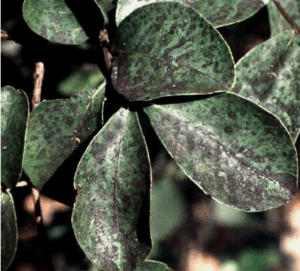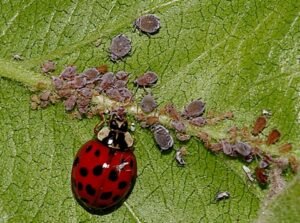Crepe myrtles are a popular landscaping option for many Gainesville yards. This is true for many reasons, not the least of which is their ability to withstand the local climate while providing year-round color and complementing a well-maintained lawn. However, as a homeowner, one problem you may encounter with them is mold. Like other areas of your home, this is something you’ll want to fix right away. So today, let’s explore how to address black mold on your crepe myrtles.
What do we mean by black mold on crepe myrtles?
Let’s start by defining what we’re talking about. Have you ever run across a black, “sooty”-like substance on your crepe myrtles? If so, this is black mold. Mold can take hold of many different things, ranging from our basements to a ceiling after a leak to various plants including crepe myrtles.
Mold is nothing more than a fungus. It grows on crepe myrtles because of “honeydew.” This is a slick, sugary substance insects frequently leave behind.
We’re all familiar with the idea of mold in our homes. It immediately conjures up images of ripping out drywall and extensive clean-up processes. In the case of your crepe myrtles, it’s not such a drastic problem.
After all, black mold on crepe myrtles isn’t a disease. Nor is it a sign of an unhealthy tree. Instead, it’s an aesthetic issue, nothing more than the aforementioned byproduct from insects.
“But mold is a health hazard elsewhere!” This is true, and the reason is the black, sooty mold that grows on crepe myrtles is from a different family. Here’s an example to better explain this: are all birds the same? Of course not. You have blackbirds and robins and bluebirds and crows and so on. They’re related, but distinctly different.
Mold is very similar, which is why this isn’t a health concern. Sooty mold is scientifically known as P. aeruginosa. It lacks the anti-respiratory health issues of Stachybotrys chartarum (“traditional” black mold).
Diving deeper: what does sooty mold look like?
So how can you be sure what you’re dealing with is sooty mold versus normal mold? That’s easy: by its appearance. Black, sooty mold on crepe myrtles will look as if the plant was too close to a bonfire. Picture this: you light a candle in your home. Unfortunately, you forgot to trim the wick and now have a discoloration of soot on your ceiling.
We’ve all been there, and usually, if we do it once we don’t do it again. Black, sooty mold looks very similar. Often, it’s the only sign of imperfection on an otherwise gorgeous tree. Better yet, black sooty mold can often be removed easily, sometimes in layers. More on this in a moment.
What causes black sooty mold on crepe myrtles?
A little bit ago, we mentioned that black, sooty mold on crepe myrtles is a byproduct of insect activity. The main culprit of black, sooty mold on crepe myrtles in Gainesville is a family of insects called aphids; elsewhere in the country, other insect families are the cause. Aphids eat honeydew, which means that after they digest it the byproduct that’s left is this black, sooty mold on your crepe myrtles.
The spores can be airborne too. Once it takes hold, it’ll grow based on various conditions such as heat, humidity, and sun/shade levels.
Wait: what are aphids and do I have them on my crepe myrtles?
Aphids are very small insects. They like to suck sap and are sometimes called black flies. They’re also known to reproduce rapidly. Once this species takes hold on a crepe myrtle they’ll be visually obvious. Other signs of a growing aphid population are leaves that droop, contain yellow spots, or both.
Is black sooty mold dangerous for my crepe myrtles?
Again, we want to emphasize that there is a difference between black mold in your home and black, sooty mold on crepe myrtles. Because they come from different scientific families, they’re not as similar as you might think.
So at the most basic level, no, black sooty mold and aphids on your crepe myrtles are not necessarily bad or dangerous for your plant.
How can I treat black mold on crepe myrtles?
Are you wondering where to begin with removing black mold from your crepe myrtles? If so, that’s easy! Just remove the existing mold before attacking the source of the problem: aphids.
As we mentioned, this can sometimes be as simple as peeling it off. Some chemical cleaners can help, though the most effective way is to work with a lawn care professional. This is one reason why some people choose regular lawn service in Gainesville, Florida.
Are there any natural ways to treat black mold?
Yes, there is a great step-by-step process to treat black mold on crepe myrtle. Remember, as with any cleaning process, water is your best friend. Just mix natural dish soap into a spray bottle and apply it to the leaves carefully. Then, wipe it off.
But what about the build-up of insects? You can take care of them naturally too by using horticultural oil or neem oil. These are both non-toxic pesticides. One thing to be mindful of is when you apply them. Both can be photosensitive, so only apply them at night to avoid UV damage to your plants.
There’s another option: you could introduce a natural predator of the aphids to your yard, such as lacewing larvae and ladybugs.

Another great way to keep all of these issues at bay is to prune your crepe myrtles each February. This will remove any issues from the previous season. Be careful not to prune them too low. We don’t recommend anything lower than eight feet.
Sun Power Lawn Care can help get rid of black mold on crepe myrtles
If you’re looking for an all-in-one solution to take care of mold on crepe myrtles as well as a way to have the best yard in Gainesville, then you’ve come to the right place. Our team offers regular lawn care visits in Gainesville, Florida, and would love to talk with you more about our various services. Just send us a message here or call (352) 507-5296 to chat with our sales team today!
Here are some great resources to help your lawn look its best:
How to Prepare Your Lawn for Spring – Maintenance Tips to Get You Ahead of The Game!
Gainesville Fl Services That Can Help You Save Time – Our Favorites!


